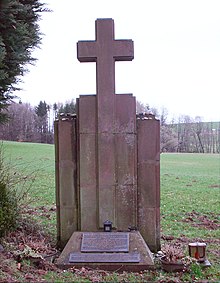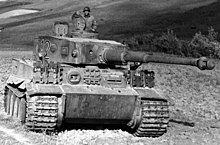Hirzenhain labor education camp
The Hirzenhain labor education camp was one of the measures for the procurement of labor in the last phase of the Second World War between mid-1943 and the end of the war in 1945 for the armaments industry of the German economy, which was oriented towards war economy.
The labor education camp was a branch of the Gestapo- operated labor education camp Heddernheim . Breuer-Werke AG, a subsidiary of Buderus AG from Wetzlar , supplied the labor camp with prisoners and forced laborers as work slaves .
Emergence
The community of Hirzenhain , which then had 600 inhabitants and belonged to the Büdingen district, is located in the Niddertal on the edge of the Vogelsberg . Hirzenhain, as the location of the Buderus factories, seemed to the armaments commandos and operations directors of the Breuer-Werke in Frankfurt-Höchst, due to its protected location in a narrow valley between two wooded hills and the existing infrastructure, to be a suitable alternative to avoid the constant danger of air attacks on the Rhine-Main -Dodge area. To date, the factory has produced iron stoves and bathtubs.
On June 30, 1943, Buderusschen Eisenwerke GmbH officially ceased operations, and on July 1, 1943, Breuer-Werke registered as a defense equipment company in Hirzenhain. The existing factory facilities were fundamentally modernized and adapted to the special conditions of forced labor. The factory premises expanded to include the barrack camps for the slave laborers. The population of Hirzenhain doubled due to Breuer and evacuees until the end of the war. In addition, there were hundreds of foreign workers , prisoners and prisoners in protection .
Recruiting the slave laborers
In 1942 it became increasingly clear to the National Socialist leadership in Germany that the material - intensive two-front war required the further development of production capacities for the armaments industry. For this purpose, large parts of the German economy were converted to war economy under state leadership and supervision . As the war lasted, it became increasingly difficult to replace the German men who were deployed in the war in all areas of the economy. For this purpose, the state resorted to forced labor, mainly from the occupied Soviet Union and parts of Poland . Responsible was the …… under the direction of the general representative for the work assignment (GBA) Fritz Sauckel . In addition, the forced laborers were cheaper for the companies and the state was able to generate income from rental fees and “ foreigner special levies ”, a business that was mutually beneficial.
The planned production lines of the Breuer-Werke were intended in particular for the VI Tiger armored vehicle, which went into series production from 1942 , and thus of particular state interest.
The slave workers at the Breuer works in Hirzenhain were requisitioned from three different sources and housed in separate storage areas that were connected to the plant to the north.
Rodgau camp for prisoners of war from 1943
The Rodgau-Dieburg prison camp (main camp I) had existed since 1938 and was expressly used to utilize the labor of prisoners who had been convicted by the higher regional courts of eastern German territories and parts of occupied Poland incorporated into the German Reich and assigned to the attorney general in Darmstadt. Only prisoners able to work outside were accommodated there. At the end of March 1942 there were 2611 prisoners. On April 30, 1942, a meeting took place in the camp under the Darmstadt public prosecutor's office about the future use of the prisoners in armaments production. In December 1942, the prison camp's board of directors and the Breuer-Werke in Frankfurt-Höchst signed a contract for the provision of 320 female Polish prisoners for their branch in Hirzenhain. The Polish women were housed in a demarcated and closed barrack area. The numbers continued to rise, so that on November 11, 1943, 239 and on October 30, 1944, 391 prisoners were housed in the Hirzenhain camp.
Camp for foreign forced laborers from 1944
From 1944 onwards, there were also many forced laborers who were employed in the Breuer works, who were recruited or abducted from their homeland to replace the German men at war. In contrast to the other workers in the camps, the forced laborers were able to leave the camp and occasionally earn extra income in the Hirzenhain community. The camp was run by Breuer himself. In January 1944, 236 people were deployed there, 181 of them Russian and Polish women. By 1944 the number of forced laborers had risen to 467, of which 72 were Poles, 382 Eastern workers, five Dutch, 26 Flemish, one Italian and four stateless. In January 1945 the camp was occupied by 938 people, including 564 Eastern workers, 166 Italians, 127 Ukrainians, 53 Poles, 17 Belgians and ten Dutch.
Labor education camp for women from 1944
The labor education camp for women was set up in the summer of 1944 as an independent women's labor education camp and was under the Frankfurt Gestapo. The camp was intended for 250 to 300 women. More than 100 Polish women were housed in the camp, who were to remain with the Breuer works as trained workers after their prison sentence was paid. Heddernheim labor education camp
production
During its existence, the Breuer-Werke produced in Hirzenhain
- Cylinder castings - crankcases, cylinder heads, intake manifolds, cylinder castings for your own engine construction,
- Power generating sets - for the radio measurement program as well as the armored troops, fast troops and for carrier frequency,
- Star pumps for hydraulic controls of the "Tiger" and " Panther " tanks .
Mass murder of the prisoners in 1945
On March 23, 1945 troops of the 3rd US Army stood in front of Wiesbaden and Mainz. On March 24th they reached Darmstadt and on March 25th the southern districts of Frankfurt. Since the beginning of March the withdrawal plans for the so-called alarm case have been prepared, according to which the commander of the Sipo and the SD -Rheinland-Westmark in Wiesbaden, the SS-Oberführer and Colonel of the Police, Hans Trummler , with his 50-60 staff members the Hirzenhain labor education camp should withdraw.
An advance command of 13 to 16 men under the command of SS-Hauptscharführer Emil Fritsch arrived at the Hirzenhain camp on March 15. The camp had not yet been cleared at this point. On March 19, the Gestapo's superior office in Frankfurt am Main gave the camp manager, SS-Hauptsturmführer and police inspector Karl-Ludwig Weimar, the order for the partial evacuation. So-called minor cases, especially German women, were then released. The women who were supposed to be sent to a concentration camp on the basis of a protective custody order from the Reich Security Main Office were deported in an evacuation march to Harmerz near Fulda .
On March 22nd, the head of the Frankfurt Gestapo, Reinhard Breder , received an order from SS-Oberführer Trummler to vacate the camp within 24 hours so that he could occupy it with his staff. Trummler's adjutant, SS-Hauptsturmführer and Detective Inspector Anton Wrede, arrived in Hirzenhain on the evening of March 23 and took command of the former labor education camp.
On the night of March 23-24, 49 female Gestapo prisoners were transported from Frankfurt by train to Hirzenhain, where they arrived that night. These were women between the ages of 20 and 40, known by name, from Poland, the Soviet Union, France, Luxembourg and Germany. During the transport, five of the women fled despite the supervision of two police officers. The camp was no longer intended to accommodate prisoners, so that on the evening of March 24th, between Anton Wrede and Reinhard Breder, who was temporarily present, a decision about the whereabouts of the newcomers and the women still in the camp must have been reached.
On the afternoon of March 25, Wrede and the camp management of the Gestapo camp selected two groups from the remaining AEL prisoners, who were supposed to be transferred to the Büdingen employment office the next morning. That same afternoon, a group of male prisoners under the supervision of the SS men from the advance detachment dug a pit about 800 m from the camp. When a guard asked about the size of the pit, SS-Hauptscharführer Fritsch declared: “This will be a petrol store.” He and his men would also take care of the release transport to Büdingen, which the guards would otherwise accompany. The work was not hidden from the population.
The two groups, the women from the Frankfurt Gestapo camp first and, after five o'clock, the prisoners selected from the camp, presumably unfit to march, were led out of the camp by SS men in the direction of Glashütten . The groups waited in the forest while two inmates were dragged out of the forest and pushed into the specially dug in the afternoon. There Emil Fritsch and young ethnic German SS men shot the prisoners with machine guns. Wrede later reported to his superior Trummler when he arrived: "The matter with the Russian women is over." 81 women and six men were murdered .
compensation
In 2000, Buderus AG joined the foundation initiative of the German economy to compensate Nazi forced laborers, which financed half of the foundation “Remembrance, Responsibility and Future” with 10 billion German marks to compensate former slave laborers of the Nazi regime.
literature
- Michael Keller: "The Russian women are over": arms production, forced labor, Gestapo concentration camps, mass murder and an SS combat group and dealing with the past at the Hirzenhain crime scene and the war grave cemetery in Arnsburg monastery 1943–1996 . Bindernagel, Friedberg (Hessen) 2000, ISBN 3-87076-087-7 (2nd greatly expanded edition).
- Klaus D. Rack, Monica Kingreen, Dirk Richhardt: Far from home under duress: the "deployment of foreign workers" during the Second World War in the Wetterau . History Association for Butzbach and the Surrounding Area, Butzbach 2004, ISBN 3-9802328-8-3 , p. 112-114 .
- LG Giessen, March 1, 1951 . In: Justice and Nazi crimes . Collection of German criminal convictions for Nazi homicides 1945–1966, Vol. VIII, edited by Adelheid L. Rüter-Ehlermann, HH Fuchs, CF Rüter . Amsterdam: University Press, 1972, No. 268, pp. 219–245. 81 female and 6 male prisoners from the AEL and the 'Extended Women's Prison' Hirzenhain were shot during the evacuation of the camp immediately before the American invasion
Individual evidence
- Unless otherwise documented from Keller, Michael: "That with the Russian women is done" - see literature
- ^ Letter from the head of the SS Main Economic Administration Office on the occasion of a visit on January 31, 1944, Buderus-Werksarchiv 179.2-51



